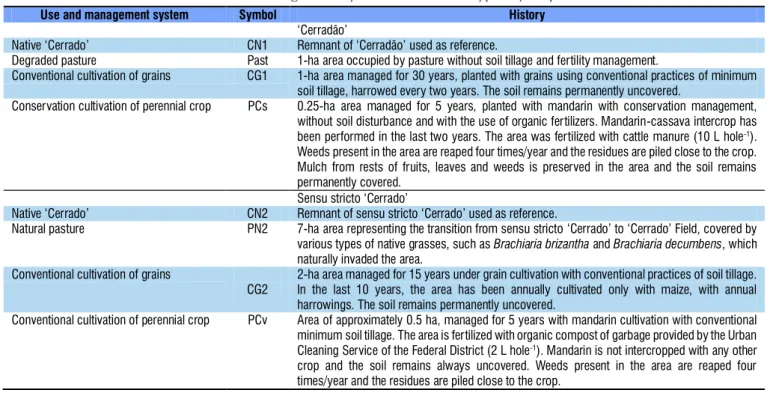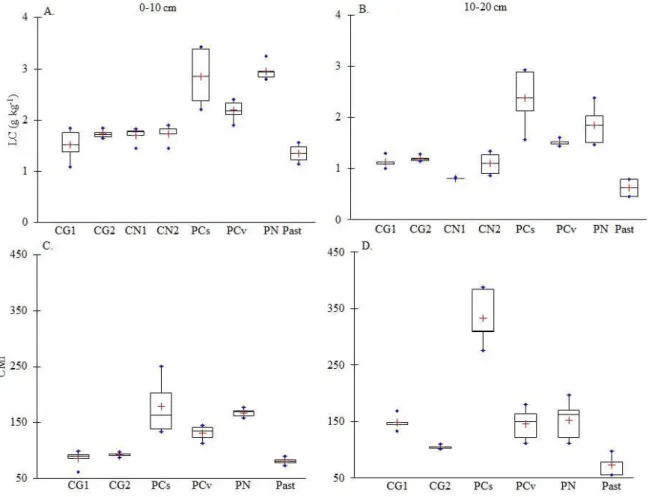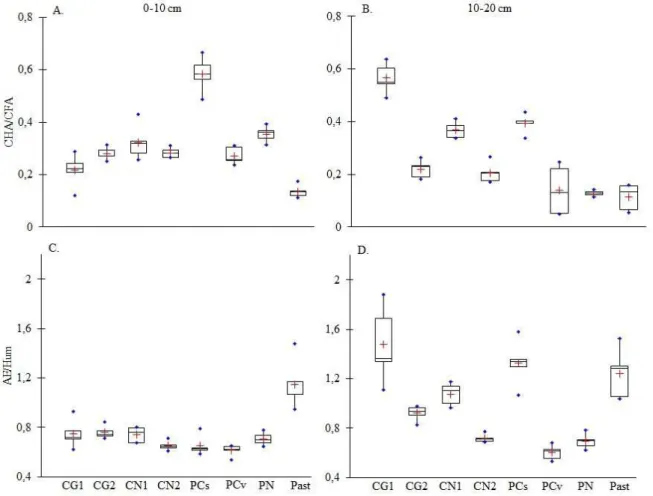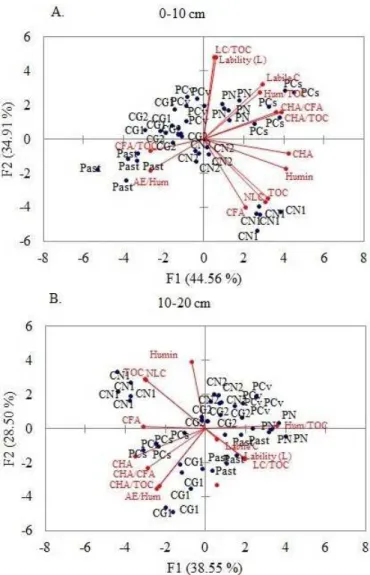Revista Brasileira de
Engenharia Agrícola e Ambiental
Campina Grande, PB, UAEA/UFCG – http://www.agriambi.com.br
v.21, n.4, p.254-260, 2017
Soil organic matter pools under management systems
in Quilombola Territory in Brazilian Cerrado
Robervone S. de M. P. do Nascimento
1, Maria L. G. Ramos
1, Cícero C. de Figueiredo
1,
Antonio M. M. Silva
1, Stefany B. Silva
1& Gilmar Batistella
1 DOI: http://dx.doi.org/10.1590/1807-1929/agriambi.v21n4p254-260A B S T R A C T
The aim of this study was to evaluate the stable and labile fractions of soil organic matter and carbon (C) management index in cultivated areas with conservation and conventional management used by Quilombola farmers in the Goiás state, Brazil. The management systems were studied in the areas of Cerradão: Native Cerrado; Pasture; Conventional grain cultivation; Conservation cultivation of perennial crop; and in the sensu stricto Cerrado: Native Cerrado; Natural pasture; Conventional grain cultivation; Conventional cultivation of perennial crop. The study was considered as observational, with five replicates. Total organic C, fractions of humic substances, labile C and C management index were determined. The Cerradão phytophysiognomy had the highest total organic C values and stable soil organic matter fractions. The native areas had low levels of labile C. The conservation cultivation of perennial crop showed the largest accumulation of total organic C in the different fractions of soil organic matter and the highest rates of C management index.
Compartimentos da matéria orgânica do solo sob sistemas
de manejo em Território Quilombola no Cerrado Brasileiro
R E S U M O
Objetivou-se, neste trabalho, avaliar os compartimentos da matéria orgânica do solo e o índice de manejo de carbono em áreas cultivadas de forma conservacionista e convencional por agricultores quilombolas, em Goiás. As áreas estudadas foram no Cerradão: Cerrado Nativo; Pastagem; Plantio Convencional de Grãos; Plantio Conservacionista de Cultura Perene; e no Cerrado sensu stricto: Cerrado Nativo; Pastagem Natural; Plantio Convencional de Grãos; Plantio Convencional de Cultura Perene. Amostras de solo foram coletadas totalizando cinco repetições em cada área. Foram determinados o carbono orgânico total, as frações das substâncias húmicas, o carbono lábil e o índice de manejo do carbono. A fitofisionomia cerradão apresentou os maiores valores de carbono orgânico total e das frações estáveis da matéria orgânica do solo. As áreas nativas apresentaram baixos teores de carbono lábil. O cultivo conservacionista foi o que apresentou os maiores acúmulos de carbono nos diferentes compartimentos da matéria orgânica e o maior índice de manejo de carbono. Key words:
labile carbon humic substances
carbon management index
Palavras-chave: carbono lábil substâncias húmicas
índice de manejo de carbono
1 Universidade de Brasília/Faculdade de Agronomia e Medicina Veterinária/Programa de Pós-Graduação em Agronomia. Brasília, DF. E-mail: robervone@hotmail.com
(Corresponding author); lucrecia@unb.br; cicerocf@unb.br; antoniomarcosunb@gmail.com; stefany.agrounb@gmail.com; gilmarb87@gmail.com
Introduction
Quilombola communities are ethnic groups formed by pluriactive, multifunctional family farmers who have the place where they live as a unit of production, consumption and social reproduction (Ribeiro, 2014). These communities do not have enough land or even adequate technical assistance. The great challenge nowadays is to guarantee food safety in the Brazilian Quilombos, with healthy foods, without compromising the environment and future generations.
Given this reality, it is necessary to inform the farmers that one of the key factors to achieve the sustainability of a production system is the maintenance of soil quality (Schiavo et al., 2011). Adequately managing an agricultural environment and maintaining it productive is a challenge that depends on the dynamic understanding on soil organic matter (SOM), which influences physical, chemical and biological attributes, with direct reflex in the stability and
yield of the agroecosystems (Costa et al., 2013).
One of the ways to evaluate SOM quality has been the quantification of carbon (C) content in its stable and labile fractions. In this context, many authors (Figueiredo et al., 2010;
Fontana et al., 2011; Costa et al., 2013) have demonstrated
the benefits of conservation systems such as no-tillage, crop-livestock integration and organic agriculture in the reduction of losses of SOM fractions and improvement of soil quality.
Considering that there are few studies evaluating SOM behavior in the Quilombos of Brazil, this study aimed to evaluate the labile and stable fractions of SOM and the indices of lability (LI) and C management (CMI) in areas under conservation and conventional cultivation by Quilombola farmers, in Goiás.
Material and Methods
The research was carried out in the Quilombo de Mesquita, located in the Mid-west region of Brazil, in the
municipality of Cidade Ocidental (16° 04' 40.79" S and 47° 52' 05.51" W), Goiás state. The Quilombo encompasses a total area of 4,292.8259 ha. In the phytophysiognomies representing the area (‘Cerradão’ and sensu stricto ‘Cerrado’), three agricultural properties were selected for sampling in order to obtain different conditions of land use in the same type of soil, despite the different vegetation.
Thus, eight types of land use, with conservation and conventional cultivation management, were selected, whose history is presented in Table 1. The soils were classified as typic dystrophic Red Latosol, with clayey texture, physically and chemically characterized according to EMBRAPA (2011), whose values are shown in Table 2.
The soil samples were collected at the end of the rainy period, in April 2014. The sampling points were established along a diagonal imaginary line in each studied environment. Five single soil samples were collected every 50 m, representing a composite sample in the layers of 0–10 and 10–20 cm. In the area under grain cultivation, sampling was performed through the collection of one sample in the row and two in the interrows of the crop. In the perennial crop and in the direction of projection of the tree crowns, the soil samples were pounded to break up clods, air-dried and sieved through a 2-mm mesh for the analyses of total organic carbon (TOC); C from the humic fractions of the organic matter (fulvic acid, humic acid and humin) and labile C (LC).
TOC was obtained without external heat source, according to EMBRAPA (2011). The humic substances (fulvic acid, humic acid and humin) were fractionated according to the methodology described by Mendonça & Matos (2005) and their C contents were quantified through oxidation of potassium dichromate. The ratios of humic acid/fulvic acid (CHA/CFA) and alkaline extract C (AE)/humin fraction C (Hum), (AE/Hum), were calculated. AE was obtained by the sum of the contents of CHA and CFA. The LC content was determined according to Mendonça & Matos (2005).
Use and management system Symbol History
‘Cerradão’
Native ‘Cerrado’ CN1 Remnant of ‘Cerradão’ used as reference.
Degraded pasture Past 1-ha area occupied by pasture without soil tillage and fertility management.
Conventional cultivation of grains CG1 1-ha area managed for 30 years, planted with grains using conventional practices of minimum soil tillage, harrowed every two years. The soil remains permanently uncovered.
Conservation cultivation of perennial crop PCs 0.25-ha area managed for 5 years, planted with mandarin with conservation management, without soil disturbance and with the use of organic fertilizers. Mandarin-cassava intercrop has been performed in the last two years. The area was fertilized with cattle manure (10 L hole-1).
Weeds present in the area are reaped four times/year and the residues are piled close to the crop. Mulch from rests of fruits, leaves and weeds is preserved in the area and the soil remains permanently covered.
Sensu stricto ‘Cerrado’
Native ‘Cerrado’ CN2 Remnant of sensu stricto ‘Cerrado’ used as reference.
Natural pasture PN2 7-ha area representing the transition from sensu stricto ‘Cerrado’ to ‘Cerrado’ Field, covered by various types of native grasses, such asBrachiaria brizanthaandBrachiaria decumbens, which
naturally invaded the area. Conventional cultivation of grains
CG2
2-ha area managed for 15 years under grain cultivation with conventional practices of soil tillage. In the last 10 years, the area has been annually cultivated only with maize, with annual harrowings. The soil remains permanently uncovered.
Conventional cultivation of perennial crop PCv Area of approximately 0.5 ha, managed for 5 years with mandarin cultivation with conventional minimum soil tillage. The area is fertilized with organic compost of garbage provided by the Urban Cleaning Service of the Federal District (2 L hole-1). Mandarin is not intercropped with any other
crop and the soil remains always uncovered. Weeds present in the area are reaped four times/year and the residues are piled close to the crop.
The changes in TOC between a reference system (native vegetation, CN1 and CN2) and a cultivated system were used to calculate the index of C compartment (ICC), as follows: ICC = TOC cultivated/TOC reference. According to the alterations in the proportions of LC and non-labile C (NLC), expressed by the lability (L) = LC/NLC in the soil, the lability index (LI) was calculated as LI = L cultivated/L reference. These two indices were used to calculate the CMI, expressed in % and obtained by the expression CMI = ICC × LI × 100 (Blair et al., 1995).
Assuming the study as observational, the results of C contents in the different fractions of SOM, the ratios of CHA/ CFA and AE/Hum, as well as the CMI, were evaluated through descriptive analysis, using Boxplots; the other variables were evaluated together through principal component analysis (PCA). All analyses were performed using the statistical program XLSTAT (2011).
Results and Discussion
Total organic C and in humic substances
In all studied managements, the values of TOC, Hum, CFA and CHA were higher in the layer of 0-10 cm, with differences between the studied treatments (Figures 1A, B, C, D, E, F, G and H).
In both layers, the CN1 showed the highest values of TOC (Figures 1A and B); in the layer of 0-10 cm, the CN1 showed the highest TOC content (61.2 g kg-1), which was 37% higher
in comparison to that of the CN2, whose mean content was
38.4 g kg-1 (Figure 1A). These results demonstrate that the
different phytophysiognomies of the Cerrado biome exhibited differences in the capacity to accumulate C in the soil.
Comparing the TOC of CN1 with those of the other
treatments, there was a reduction that ranged from 37 to
58%. The treatment PCs, in which soil conservation practices prevailed, showed the lowest losses of TOC in the studied layers. In the layer of 0-10 cm, the TOC contents in PCs were similar to those of CN2 and PN (Figure 1A).
It should be pointed out that the mean TOC contents found in the systems CN1, CN2, PN and PCs are above those observed in Cerrado Latosols with clayey texture and cultivated under no-tillage (Schiavo et al., 2011).
In general, the conventional managements (CG1, CG2, PCv and Past) led to the highest losses of TOC (Figures 1A and B). For Silva et al. (2011), the conversion of native vegetation areas into agricultural cultivation resulted in the decrease of TOC contents, alterations that are smaller when a conservation practice of soil tillage is adopted, as in the case of the treatment PCs.
Regarding C distribution in the stable fraction of SOM, there was a predominance of humin (Hum) in comparison to the fractions humic acid (HA) and fulvic acid (FA), regardless of the analyzed management systems and layers (Figures 1C, D, E, F, G and H).
For Dick et al. (2005), the higher C contents in the Hum in comparison to the other SOM fractions are observed in tropical soils. This result is attributed to both the hydrophobicity and the strong organo-mineral interaction of this fraction. In the present study, the different types of management altered the C contents in the humin fraction and the highest values were found in the layer of 0-10 cm, ranging from 16.1 to 47.4 g kg-1.
The highest mean values of Hum were found in CN1 (47.4 g kg-1), PCs (37.4 g kg-1), PN (31.1 g kg-1) and CN2 (29.9 g kg-1)
and the lowest ones in the areas of conventional management (Past, CG1, CG2 and PCv) (Figure 1C and D), while the lowest value of Hum was found in Past (16.1 g kg-1). The highest
values of Hum found in CN1 are due to the lower disturbance level of the area, which promotes greater polymerization of humic compounds. This differentiation of the values of Hum with the adopted type of management was also observed in the study of Sousa et al. (2015), in which the conventional soil tillage for vegetable production reduced Hum contents in comparison to the no-tillage.
According to Figure 1E, F, G and H, the CFA contents were higher than those of CHA, and the lowest values of these fractions were found in the layer of 10-20 cm. The predominance of CFA contents demonstrates that the entry of organic matter, especially in systems under natural vegetation and conservation, is constant, which favors the accumulation of fractions with lower degree of humification. In the layer of 0-10 cm, the CN1 was the management with highest value of CFA, 26.50 g kg-1, while the other managements showed
similar values. However, in the layer of 10-20 cm, the highest (1)CN1 - ‘Cerradão’; PCs - Conservation cultivation of perennial crop; Past - Degraded pasture; CG1 - Conventional cultivation of grains; CG2 - Sensu stricto ‘Cerrado’; PCv - Conventional
cultivation of perennial crop; PN - Natural pasture; CG2 - Conventional cultivation of grains; The analyses of the soil were performed using samples from the layer of 0-10 cm; m - Aluminum saturation
Managements(1) pH
in H2O
Al+3 Ca2+ Mg2+ H + Al P K m
(%)
Silt Sand Clay
(cmolcdm-3) (mg dm-3) (g kg-1)
‘Cerradão’
CN1 5.1 0.55 4.06 1.34 9.0 1.3 148 8.7 410 40 550 PCs 5.8 0.06 6.34 1.95 5.7 3.7 308 0.6 410 40 550 Past 4.7 0.64 0.34 0.28 5.9 2.1 118 41.0 280 120 600 CG1 5.9 0.03 4.57 1.28 4.1 8.4 353 0.4 410 40 550
Sensu stricto ‘Cerrado’
CN2 4.7 0.72 0.07 0.19 6.2 0.8 54 11 270 100 630 PCv 5.2 0.19 1.08 0.73 5.5 1.8 186 2.4 270 100 630 PN 4.7 0.63 0.33 0.36 7.0 0.9 76 8.0 270 100 630 CG2 5.2 0.10 1.79 1.07 5.4 7.8 79 1.2 270 100 630
Figure 1. Boxplot of the contents of total organic carbon (TOC) and carbon in the fractions humin (Hum), fulvic acid (CFA) and humic acid (CHA) in the layers of 0-10 and 10–20 cm
values of CFA occurred in the conservation management (PCs) and in CN1, 17.9 and 17.8 g kg-1, respectively. In these
systems, besides the greater supply of organic matter and absence of soil disturbance, there is a reduction in the rates of humification, represented by greater accumulation of the CFA fraction. As the CHA fraction, the highest values were 8.94 and 8.52 g kg-1, found respectively in the managements PCs
and CN1, while the lowest CHA contents were found in the conventional managements (Past, CG1, CG2 and PCv). These results corroborate those obtained by Fontana et al. (2011), who reported higher CHA contents in areas under natural vegetation of the Atlantic Forest and under agroforestry system, compared with the conventional plantations of banana.
Effect of the soil use systems on organic matter lability
The highest LC contents were obtained in the layer of 0-10
cm, and the maximum value was equal to 3.44 g kg-1, found
in the PCs and close to that found in the PN. The lowest value
was observed in Past (1.36 g kg-1) (Figure 2A and B). Silva et
al. (2011) and Leite et al. (2013) indicate that conservation
systems favor the maintenance of crop residues on soil surface, promoting slow decomposition of the deposited plant material and favoring LC accumulation.
In the native areas (CN1 and CN2), the mean values of LC were similar, but lower in comparison to the systems PCs, PN, PCv, and higher than those in Past, CG1 and CG2. This
behavior was also observed by Figueiredo et al. (2010), who reveal that, possibly, the low LC content in native areas is due to the predominance of compounds of higher chemical stability and high molecular weight, such as lignin, under natural vegetation. These compounds are not quantified when potassium permanganate is used as the oxidation agent (Blair et al., 1995). In addition, the lower proportion of C in the labile form probably explains the higher contents of TOC in areas under natural vegetation in the Cerrado biome obtained in other studies (Figueiredo et al., 2010; Leite et al.,
2013).
Considering CN1 as the reference native area, in the layer of 0-10 cm, only the management PCs showed CMI higher than 100% (178%), which was the highest value among the studied treatments. On the other hand, Past and CG1 showed CMI of 81 and 86%, respectively. Taking CN2 as the reference area, only the management CG2 showed CMI
lower than 100% (93%), while PCv and PN showed CMI of 132 and 167% (Figure 2C). Soil management systems with
CMI values above 100% indicate that, in these systems, the adopted management increased soil quality, constituting a favorable practice to the maintenance of SOM. These results corroborate those observed by Schiavo et al. (2011), who identified the system with Brachiaria as the one with highest CMI, the closest one to that of the natural Cerrado vegetation. However, in the layer of 10-20 cm, there was a
Figure 2. Boxplot with the contents of labile carbon (LC) and carbon management index (CMI) in the layers of 0-10 and 10-20 cm
positive effect on the increase of C in the soil, with higher values of CMI for the managements PCs, CG1, CG2 and
PCv, equal to 334, 148, 105 and 146, respectively. This can
be due to the incorporation of the organic residues in the conventional systems of grain cultivation and the large supply of organic fertilizer in the conservation systems, whose C accumulation reaches the layer of 10-20 cm, although there was no reduction in the systems PN and
Past, 153 and 73, respectively, while the management Past
showed CMI below 100 (Figure 2D).
The CHA/CFA ratio is normally used as indicator of quality of humic substances, to express the degree of evolution of the humification process (Fontana et al., 2011). In tropical soils, this ratio is usually lower than 1, due to the low intensity of the humification processes. In the present study, in all evaluated management systems and layers, the
CHA/CFA ratio was lower than 1 (Figure 3A and B), and
the highest values were found in the layer of 0-10 cm. The reduction of this ratio from the layer of 0-10 cm to 10-20 cm reflects the characteristic of higher solubility and mobility of CFA, being distributed along the soil profile (Fontana et al., 2011).
For the AE/Hum ratio (Figure 3C and D), all values were
lower than 1, except for the pasture (Past), whose value was 1.14. However, these results demonstrate a high degree of organic matter humification in the studied soils.
Principal component analysis
The distribution of the analyzed variables showed cumulative variance of 79.47 and 67.05% for the principal components in the layers of 0-10 and 10-20 cm, respectively (Figures 4A and B). In the layer of 0-10 cm, the axis CP1 separated four groups: CN1; PN/PCs; CN2 and Past/CG1/ CG2/PCv (Figure 4A).
The native area (CN1) showed the best quality of SOM, which is explained by the high values of TOC, CHA, CFA, Humin and NLC (Figure 4A). In this native area, although the soil exhibited low base saturation (42%), there is a different natural fertility in this site, which justifies the fact that these areas are more used by the Quilombola farmers for agricultural activities.
SOM quality in the management PCs was similar to that of natural pasture (PN) and this behavior is explained by the lability, LC and by the CHA/CFA ratio. It should be pointed out that the management PCs showed the lowest reductions of the studied variables. These results highlight the necessity of intensive use of sustainable soil management systems by the Quilombola farmers, with rigorous use of conservation practices (no-tillage, organic fertilization, etc.) that allow to preserve SOM and the reserves of nutrients. However, the existence of few appropriate technologies and the lack of information on the reality of these farmers have led to the use of technically incorrect practices, which have caused soil impoverishment and yield reduction.
Costa, A. R.; Sato, J. H.; Ramos, M. L. G.; Figueiredo, C. C.; Souza, J. P.; Rocha, O. C.; Guerra, A. F. Microbiological properties and oxidizable organic carbon fractions of an Oxisol under coffee with split phosphorus applications and irrigation regimes.
Revista Brasileira de Ciência do Solo, v.37, p.55-65, 2013. https:// doi.org/10.1590/S0100-06832013000100006
Dick, D. P.; Gonçalves, C. N.; Dalmolin, R. S. D.; Knicker, H.; Klamt, E.; Kogel-Knabner, I.; Simões, M. L.; Martin Neto, L. Characteristics of soil organic matter of different Brazilian Ferralsols under native vegetation as a function of soil depth.
Geoderma, v.124, p.319-333, 2005. https://doi.org/10.1016/j.
geoderma.2004.05.008
EMBRAPA - Empresa Brasileira de Pesquisa Agropecuária. Manual de métodos de análise de solo. 2.ed. Rio de Janeiro: Centro Nacional de Pesquisa de Solos, 2011. 627p.
Figueiredo, C. C.; Resck, D. V. S.; Carneiro, M. A. C. Labile and stable fractions of soil organic matter under management systems and native cerrado. Revista Brasileira de Ciência do
Solo, v.34, p.907-916, 2010. https://doi.org/10.1590/S0100-06832010000300032
Fontana, A.; Silva, C. F.; Pereira, M. G.; Loss, A.; Brito, R. J. B.; Benites, V. M. Avaliação dos compartimentos da matéria orgânica em
área de Mata Atlântica. Acta Scientiarum. Agronomy, v.33,
p.545-550, 2011.
Leite, L. F. C.; Arruda, F. P.; Costa, C. N.; Ferreira, J. S. F.; Holanda Neto, M. R. Qualidade química do solo e dinâmica de carbono sob monocultivo e consórcio de macaúba e pastagem. Revista Brasileira de Engenharia Agrícola e Ambiental, v.17,
p.1257-1263, 2013. https://doi.org/10.1590/S1415-43662013001200002
Mendonça, E. S.; Matos, E. S. Matéria orgânica do solo: Métodos de análises. Viçosa: UFV, 2005. 107p.
Ribeiro, A. S. S. Saberes tradicionais e educação ambiental: encontros e desencontros no Quilombo de Mesquita- Goiás. Brasília: UnB, 2014. 284p. Tese Doutorado
Schiavo, J. A.; Rosset, J. S.; Pereira, M. G., Salton, J. C. Índice de manejo de carbono e atributos químicos de Latossolo Vermelho sob diferentes sistemas de manejo. Pesquisa Agropecuária
Brasileira, v.46, p.1332-1338, 2011. https://doi.org/10.1590/
S0100-204X2011001000029
Silva, E. F.; Lourente, E. P. R.; Marchetti, M. E.; Mercante, F. M.; Ferreira, A. K. T.; Fuji, G. C. Frações lábeis e recalcitrantes da matéria orgânica em solos sob integração lavoura-pecuária.
Pesquisa Agropecuária Brasileira, v.46, p.1321-1331, 2011.
https://doi.org/10.1590/S0100-204X2011001000028
Sousa, R. F.; Brasil, E. P. F.; Figueiredo, C. C.; Leandro, W. M. Soil organic matter fractions in preserved and disturbed wetlands of the cerrado biome. Revista Brasileira de
Ciência do Solo, v.39, p.222-231, 2015. https://doi. org/10.1590/01000683rbcs20150048
XLSTAT 2011. Statistical software to MS Excel. New York: Addinsoft, 2011.
CN1 - ‘Cerradão’; PCs - Conservation cultivation of perennial crop; Past - Degraded pasture; CG1 - Conventional cultivation of grains; CN2 - Sensu stricto ‘Cerrado’; PCv - Conventional cultivation of perennial crop; PN - Natural pasture; CG2 - Conventional cultivation of grains Figure 4. Principal component analysis of the stable and mineralizable pools of soil organic matter in the layers of 0-10 and 10-20 cm
Conclusions
1. The phytophysiognomy Cerradão showed the highest values of total organic carbon and stable fractions of soil organic matter.
2. The native areas showed low contents of labile carbon.
3. The conservation cultivation led to the highest
accumu-lations of carbon in the different fractions of the organic matter and highest indices of lability and carbon management.





